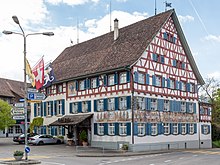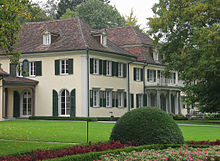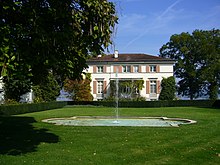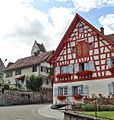Ermatingen
| Ermatingen | |
|---|---|
| State : |
|
| Canton : |
|
| District : | Kreuzlingen |
| BFS no. : | 4646 |
| Postal code : | 8272 |
| UN / LOCODE : | CH EMG |
| Coordinates : | 723 264 / 281142 |
| Height : | 400 m above sea level M. |
| Height range : | 395–613 m above sea level M. |
| Area : | 10.46 km² |
| Residents: | 3455 (December 31, 2018) |
| Population density : | 259 inhabitants per km² |
| Website: | www.ermatingen.ch |
|
, Ermatingen by Fruthwilen seen from |
|
| Location of the municipality | |
Ermatingen is a municipality and a town in the district of Kreuzlingen in the canton of Thurgau in Switzerland . The unitary community of Ermatingen was created in 1975 through the merger of the former municipal community of Ermatingen with their local communities of Ermatingen and Triboltingen .
geography
Ermatingen is located on the south bank of the Untersee part of Lake Constance opposite the island of Reichenau and consists of the districts of Ermatingen and Triboltingen . The lowest point of the municipality is the lake shore in the north and lies at approx. 396 m above sea level. M. , the highest is on the Seerücken on the southern border of the municipality at 613 m above sea level. M.
geology
Much of the village was built on a river delta built that since the last ice age ( Würm ) was filled in by the village stream. It is the largest delta of the Untersee . The village stream created by the confluence of two rivers whose headwaters typical molasses tobel have eroded. The molasse here is largely composed of mica sand and Nagelfluh . The mica sands were brought in from Bavaria using an electricity system . This sand used to be mined, today the Cholhoo gravel pit is evidence of it . The Nagelfluh was brought in from the Alps and is part of the Hörnli rubble fan that was raised by the Ur-Rhine. Above it lies moraine material from the last Ice Age. This was mainly deposited as a ground moraine , but there are also some side moraine walls. The gray stone boulder , which was carried here by the Rhine Glacier, is located in the municipality .
history
Stone Age finds suggest that the first settlers here around 3000 BC. BC settle down. They built their pile dwellings in the sheltered bays near Ermatingen. The Stone Age bank settlements of Westerfeld and Büge were examined for the first time in 1861 and from 1981 to 1983, with finds from the Pfyner , Horgener and Schnurkeramik cultures (4000-2500 BC) uncovered .
Reichenau and Constance rule

The early medieval settlement is documented by an Alemannic burial ground. Erfmotingas is mentioned for the first time in 724 in a document in which Karl Martell donated the village to the Reichenau monastery. Ermatingen was part of the basic equipment of the Reichenau monastery , whose abbot was Kollator , landlord and court lord. A Meier monastery and later an Ammann was used to exercise the lower jurisdiction . The Meieramt ( Vogtei ) was often pledged, including the Lords of Klingenberg until 1446 . Openings are documented in the 13th century and in 1518 .
Even after the conquest of Thurgau by the Confederates in 1460, the lower jurisdiction remained with the abbot. During the Swabian War in 1499 large parts of the village were destroyed by the Swabian army. Since the 16th century at the latest, Ermatingen had a small and large council based on the city model, its own court - each chaired by the Ammann - and various privileges. In 1660, Ermatingen received market rights from the governing federal towns . After the Reichenau Abbey was incorporated into the Konstanz Monastery in 1540, the Lower Court of Ermatingen belonged to the Bishop (Upper Bailiwick Reichenau) until 1798 as the so-called Neustiftische dominion.
In 1756 the community acquired all the property , apart from mills and water rights, and in 1763 the shoemaker's guild was established . At the end of the 18th century, Ermatingen owned, among other things, customs duties and shipping rights. On April 17, 1799, French troops marched into Ermatingen. The final replacement from Konstanz took place in 1839.
Parish
The parish of Ermatingen originally extended from the lake to over the Seerücken . The Mannenbach and Triboltingen chaplains were established in the High Middle Ages . In 1359 the Ermatingen Church was incorporated into Reichenau Abbey. 1528 almost the whole village under the direction of the Konstanz pastor Alexius Bertschi evangelisch , said Abbey, or from 1540 Bishop of Konstanz, in the majority reformed Parish to 1804 the Kollatur retained. After the Second Kappel War , some Catholic families moved back to Ermatingen. The village church has been used equally since 1546 . In 1723/24, Wäldi separated from the Reformed parish of Ermatingen, and in 1949 Gunterswil and Hohrain were also transferred to Wäldi.
19th and 20th centuries
After the defeat of Napoleon I , many French aristocrats settled on the Untersee. Hartmann Friedrich Ammann from Ermating founded the cantonal shooting club in 1835 together with Prince Louis Napoleon in the Hirschen restaurant.
In the 19th century fishing ( gang fishing), grain, fruit, hemp and viticulture (wine trade) formed the basis of the village economy. With the expansion of the Seestrasse in 1823, the steamship operation on the Untersee from 1825 and the opening of the Etzwilen – Konstanz railway line in 1875, the traffic situation improved, after which tourism began after 1870. At the end of the 19th century, mechanical embroidery and ship embroidery gained a foothold in Ermatingen. In 1848, with a carpenter's shop (from 1936 Jacques Goldinger AG) and in 1875 with what was later to become the tin can and aluminum goods factory Louis Sauter AG, other companies established themselves in Ermatingen, which increasingly displaced agriculture in the 20th century.
Although a fish hatchery and the traditional bullhead carnival are reminiscent of commercial fishing, Ermatingen has been primarily known as a training location since 1975 with the UBS Castle Wolfsberg training center and since 1989 with the Lilienberg Entrepreneur Forum. In 2000, almost two thirds of the jobs were in the third economic sector .
Since June 1, 1975, the two former local communities Triboltingen and Ermatingen have formed the unitary community of Ermatingen.
See also
→ History section in the article Triboltingen
coat of arms
Blazon : A white male in black with a yellow collar and a yellow tongue.
The coat of arms can be proven on a coat of arms disk from 1596. The community continued to use after the unified community was formed from Ermatingen and Triboltingen in 1979.
population
 |
| 1850 | 1900 | 1950 | 1970 | 1980 | 1990 | 2000 | 2010 | 2018 | |
|---|---|---|---|---|---|---|---|---|---|
| Unified Church | 1992 | 2171 | 2427 | 2874 | 3454 | ||||
| Municipal parish | 1708 | 1728 | 2029 | 2089 | |||||
| Local parish | 1363 | 1414 | 1787 | ||||||
Of the total of 3,454 inhabitants in the municipality of Ermatingen in 2018, 1,087 or 31.5% were foreign nationals. 1383 (40.0%) were Protestant Reformed and 949 (27.5%) were Roman Catholic. At that time, the village of Ermatingen had 3012 residents.
economy
In 2016, Ermatingen offered work for 843 people (converted to full-time positions). 4.2% of these were employed in agriculture and forestry, 28.7% in industry, trade and construction and 67.1% in the service sector.
fishing
In addition to trade and commerce, fishing was an important line of business in Ermatingen. From this time z. B. the stately house of the former fish shop Läubli in Oberstaad and three large fishing boats from the days of trawling, which were formerly on display on the banks of the Horn .
Transport and infrastructure
The Swiss National Railway opened on July 17, 1875, on the Etzwilen – Konstanz / Kreuzlingen Hafen railway line, part of the lake line . This means that Ermatingen was connected to the rail network. In summer, the village can also be reached by regular boat (Schaffhausen – Kreuzlingen line of the Swiss Untersee and Rhine shipping company ).
Ermatingen and the surrounding area are supplied with radio programs by Swisscom Broadcast from the German island of Reichenau on Lake Constance via the Reichenau filling station .
Attractions
The villages of Ermatingen and Triboltingen as well as the Untersee castle landscape are listed in the inventory of places worth protecting in Switzerland .
Parity Church
The origins of the Paritätische Kirche Ermatingen , also known as Paritätische Kirche St. Albin , go back to the 12th or 13th century. It was sacked in the Swabian War in 1499. In the course of the Reformation , the pictures and altars were removed from the church. After the second country peace , the parity ratio was restored, since then it has been used jointly by the Roman Catholic and Protestant congregations. In 1649 a major renovation was carried out. In 1749/1750 there was a major renovation under the master builder Johann Michael Beer , the altarpieces and the choir vault were painted by Franz Ludwig Hermann .
Gasthaus "Adler"
The "Adler" is one of the oldest inns in the canton of Thurgau. It was first mentioned in 1270. Today's stately block building dates from the 16th century. It also served the federal governor as an audience place.
Famous guests were u. a. Prince Louis Napoleon , François-René de Chateaubriand , Alexandre Dumas , Thomas Mann , Graf Zeppelin , Hermann Hesse , Hugo Ball , Leonhard Frank , René Schickele , Ferdinand Hardekopf , Alfred Neumann or General Guisan .
Wolfsberg Castle
In 1571 Wolf Walter von Gryffenberg built a cube-shaped castle building far above the village. Johann Friedrich Geldrich of Sigmarshofen , who bought it in 1595, received the Good for his low jurisdiction and Wolfsberg has outdoor seating .
In 1731 Junker Johannes Zollikofer bought it, who rebuilt it in the form Wolfsberg still shows today. In 1795 the St. Gallen banker Jean Jacques Hoegger (1747–1812) bought the castle and probably had the Parquin House built in 1797 to the southwest of the castle. After Hoegger's death, his daughter Juliane Wilhelmine (1776–1829) inherited it, who sold the property in 1815 to Baron Ignaz von Wechingen from Feldkirch . In 1824 the castle came into the possession of the French Colonel Charles Parquin . He had Wolfsburg Castle rebuilt and set up a pension here, which was closed in 1839. Other owners were the Englishman Joseph Martin Parry, who converted the estate into a model agricultural business, and Karl Bürgi, who set up a spa house around 1865, which remained in existence until 1918.
Under the crime writer Wolf Schwertebach , Wolfsberg was the meeting place for SS Brigadier Walter Schellenberg (1910–1952) and Colonel Brigadier Roger Masson in 1942/1943 . In 1970 the castle was acquired by the Swiss bank UBS , which renovated it and expanded it into a training center with additional buildings on the site. On the west wall of the library building there is an iron clockwork from the old castle, which was made by Laurentius Liechti around 1540 .
Villa Lilienberg
The Lilienberg was built around 1840 by the Prussian baroness Caroline von Waldau. In 1848 they were bought by Baroness Betty von Fingerlin; her husband, Count Johann Baptist Zappi, was a friend of Napoleon III. The stately villa in the style of late classicism went to the Winterthur company Gebrüder Volkart in 1897 and to the Reinhart family in 1935. Werner Reinhart renovated the villa and housed a. a. Wilhelm Furtwängler and Othmar Schoeck . The art patron Oskar Reinhart also lived here. The area was acquired in 1985 by the Lilienberg Entrepreneur Forum Foundation and is now a meeting center for entrepreneurs.
«Villa am See» (Villa Sauter)
This villa in the style of an Appenzell house was built in 1798 by the Appenzell master builder Grubenmann on the site of the former bathroom , which was demolished in 1782 .
The house became known as «Toblerhaus» and had been owned by the entrepreneur Louis Sauter (Villa Sauter) since 1918. The German textile entrepreneur Uwe Holy acquired the building in 2005 and renovated it together with the listed building.
Hard Castle
In 1520 Sebastian Muntprat rebuilt Hard Castle after the previous building from the 13th century had been destroyed in the Swabian War. It was a stately building with a gable roof and a domed turret. The castle was demolished in 1982.
Rellingsches Schlösschen
The estimated from the 12./13. The house, which dates back to the 19th century, burned down in the Swabian War, was rebuilt in 1501 and from 1579 served as a patio for Junker Jechonias Rellingen von Feder. The eastern part of the house stands as a square tower on high wall plinths; the stairwell was added to it in 1686. The western part of the house was later added as a trot . The oak posts that survived the fire of 1499 still stand today in the former trot. Thanks to the adaptations made by the owners for their needs, this building has been preserved and cared for. It is probably the oldest well-preserved building in Ermatingen.
Chapel of St. Niklaus Triboltingen
→ see section Chapel St. Niklaus in the article Triboltingen
regional customs
During the Council of Constance (1414-1418) one of the three antipopes , John XXIII. , secretly fled Constance and came to Ermatingen. According to tradition, the Pope is said to have allowed the Ermatingern to celebrate Carnival again at this time as thanks for the food. The people of Ermating therefore attribute the Groppenfasnacht , which takes place every three years on Sunday Laetare , three weeks before Easter, to this papal visit.
Another important more recent custom is “gang fish shooting”. This was carried out for the first time in 1937 and is the largest winter shooting in Switzerland. Every year in December, it attracts hundreds of shooters to Ermatingen. The gang fish prepared according to a special recipe is also eaten.
natural reserve
In winter, the fishermen from Ermating made their living from hunting water birds. After constant denunciation of this hunt, nature and bird protection associations launched a popular initiative to abolish it. In the voting campaign that followed, there was much controversy surrounding this hunt, which conservationists called the "Belchenschlacht". The initiative was accepted in 1984 as the first popular initiative in the canton of Thurgau with a majority of around 1,000 votes.
Since the winter of 1984/1985, patent hunting , the so-called "little man's hunt", has been banned. Contrary to the promises of the conservationists, the water bird reserve in the Ermatinger Basin was demanded and created. Since then, thousands of ornithologists have come to the Untersee every winter . A cultural-historical piece of hunting has been preserved in the form of carved decoys.
Personalities
- Marie Espérance von Schwartz (1818–1899), German-English writer (had her last residence here)
- Konrad Ilg (1877–1954), Swiss trade unionist (born in Ermatingen)
- Hermann Fehr , (1909–1992), Swiss politician ( SP ), (honorary citizen of Ermatingen)
- Ferenc Fricsay (1914–1963), Austrian conductor (lived here from 1952, is buried in the cemetery in Ermatingen)
- Ernst Graf (1909–1988) painter and graphic artist (honorary citizen of Ermatingen)
- Ernst Mühlemann (1930–2009), Swiss politician (FDP) and member of the National Council
- Roberto Blanco (* 1937), German entertainer (lives in Ermatingen)
- Uwe Holy (* 1940), founder and owner of the Holy Fashion Group (lives in Ermatingen in the new building built by Herzog & de Meuron next to the Villa Ulmberg )
- Hermann Fehr (* 1941), former mayor of Biel / Bienne, government councilor of the canton of Bern, national councilor (grew up in Ermatingen); his father Hermann Fehr (1909–1992) was mayor and honorary citizen of Ermatingen.
- Thomas Ammann (1950–1993), Swiss art collector and dealer
- Bas de Leeuw (* 1959), Dutch economist, World Resources Forum, Club of Rome (lives in Ermatingen)
- Marco Werner (* 1966), German automobile racing driver (lives in Ermatingen)
- Dani Felber (* 1972), Swiss musician, band leader and composer (lives in Ermatingen)
- Toto Wolff (* 1972), Austrian investor and racing car driver (lives in Ermatingen)
- Dirk Müller (* 1975), German automobile racing driver (GT 2) (lives in Ermatingen)
- Lucas Luhr (* 1979), German automobile racing driver (DTM) (lives in Ermatingen)
- Edward Sandström (* 1979), Swedish racing car driver (lives in Ermatingen)
- Katherine Legge (* 1980), British racing driver (DTM) (lives in Ermatingen)
- Alexandre Prémat (* 1982), French racing driver (DTM) (lives in Ermatingen)
- Susie Wolff (* 1982), British racing driver (Formula 1, DTM) (lives in Ermatingen)
- Oliver Jarvis (* 1984), British racing driver (DTM) (lives in Ermatingen)
literature
- Arnold Bosshard, Peter Funk, Alfons Raimann: Ermatingen and Triboltingen TG. ( Swiss Art Guide, Volume 413/414). Edited by the Society for Swiss Art History GSK. Bern 1988, ISBN 978-3-85782-413-5 .
- Regine Abegg, Peter Erni, Alfons Raimann: The art monuments of the canton of Thurgau, Volume VIII: Around Kreuzlingen. (= Art Monuments of Switzerland. Volume 125). Edited by the Society for Swiss Art History GSK. Bern 2014, ISBN 978-3-03797-116-1 , pp. 66–152.
photos
→ see also section pictures in the article Triboltingen
Web links
Individual evidence
- ↑ Permanent and non-permanent resident population by year, canton, district, municipality, population type and gender (permanent resident population). In: bfs. admin.ch . Federal Statistical Office (FSO), August 31, 2019, accessed on December 22, 2019 .
- ↑ a b Thurgau in figures 2019 . On the website of the Statistical Office of the Canton of Thurgau (PDF file; 1.8 MB), accessed on April 28, 2020.
- ↑ Swiss land use statistics. Completed on July 1, 1912. Published by the Federal Statistical Bureau. ( Memento from April 12, 2016 in the Internet Archive )
- ↑ a b Localities and their resident population. Edition 2019 . On the website of the Statistical Office of the Canton of Thurgau (Excel table; 0.1 MB), accessed on April 28, 2020.
- ^ Vorarlberger Landesmuseum Bregenz, in: Listed! Finds of pile dwellings on the Untersee. In: Südkurier of September 9, 2011.
-
↑ a b c d e f g Verena Rothenbühler: Ermatingen. In: Historical Lexicon of Switzerland .
These sections are largely based on the entry in the Historical Lexicon of Switzerland (HLS), which, according to the HLS's usage information, is under the Creative Commons license - Attribution - Share under the same conditions 4.0 International (CC BY-SA 4.0). - ↑ a b municipal coat of arms . On the website of the State Archives of the Canton of Thurgau, accessed on December 8, 2019
- ↑ a b c population development of the municipalities. Canton Thurgau, 1850–2000 and resident population of the municipalities and change from the previous year. Canton of Thurgau, 1990–2018. On the website of the Statistical Office of the Canton of Thurgau (Excel tables; 0.1 MB each), accessed on April 28, 2020.
- ↑ Swiss rail network. Published by the SBB General Secretariat, Bern 1980, p. 23.
- ↑ Cornelia Stäheli: Wolfsberg Castle near Ermatingen. ( Swiss Art Guide, No. 687, series 69). Ed. Society for Swiss Art History GSK. Bern 2001, ISBN 978-3-85782-687-0 .
-
↑ a b Erich Trösch: Wolfsberg. In: Historical Lexicon of Switzerland .
These sections are largely based on the entry in the Historical Lexicon of Switzerland (HLS), which, according to the HLS's usage information, is under the Creative Commons license - Attribution - Share under the same conditions 4.0 International (CC BY-SA 4.0). - ↑ Pierre-Th. Braunschweig: Secret line to Berlin. Zurich 1990, 3rd edition, p. 228
- ↑ The former bathing room in Ermatingen
- ↑ Villa on the lake
- ↑ Gang fish food in the database of Culinary Heritage of Switzerland
- ↑ René E. Honegger: Lure ducks from Untersee - on the cultural history of the former water bird hunting. ( Memento from July 17, 2015 in the Internet Archive ) (PDF; 3.5 MB)
- ↑ Harald Borges: Please, be so nice and do it again. About the conductor Fricsay in Ermatingen. In: seemoz , August 5, 2014
- ↑ Peter Exinger: WORLD CITIZENS: Roberto Blanco: “Switzerland is my bedroom” on tagblatt.ch, accessed on July 5, 2018
- ↑ Diju - Encyclopedia of Jura - Biel (Mayor). Retrieved March 28, 2017 (French).
- ↑ Hermann Fehr - Vinorama Museum Ermatingen. Retrieved March 14, 2017 .

















